“By 2023, 60% of organizations will depend on EA’s role to lead the business approach to digital innovation” - Gartner report: Enterprise Architecture Enables Digital Innovation.
Across industries, there’s a growing appreciation of a new kind of Enterprise Architecture (EA). The critical need for insight into inter-connections across sprawling organizations and the business value of dynamic, digestible data is dawning on us faster than most EA teams feel they can keep up.
What sounds like a mouthful of shiny buzzwords is in reality hitting the boardrooms and meeting agendas of IT leaders, CTO’s, and a growing number of business leaders in your sector.
You’re probably reading this article because you’re already feeling the pressure to deliver (and fast). Whether you’re just restarting your Enterprise Architecture efforts from scratch or building a mature function that’s delivering directly to the business leaders calling the shots - you’ve probably found yourself wondering how other Enterprise Architecture teams in other organizations are dealing with this growing need.
Are they facing similar scaling issues? Are they managing to communicate their value? What mistakes have they made and how can we learn from them?
So, we asked our customers for you. More than 100 respondents from all around the world responded, including the US, Norway, Switzerland, Germany, Canada, and Australia.
These experts work within a variety of industries such as Insurance, Information Technology & Services, Government Administration, Higher Education, and Accounting. The quality of data this spectrum provided by the experience that they’ve shared with us has made this survey rich with useful information.
Here we’ll take you through the results of the top 5 mistakes Enterprise Architecture teams are making, as told by EA’s themselves. Then, we’ll show you what to do to avoid, repair, and succeed in all of the key areas holding you back.
Want to skip straight to the full survey report with all the actionable tips? Click here to get your copy of 5 Mistakes to Avoid in Enterprise Architecture.
The Top 5 Mistakes Being Made in Enterprise Architecture
5. Working With Unorganized Data
Over 9% of Enterprise Architects said that this was their biggest hurdle in reaching their goals.
We get it: organizations and their needs have never been more complex (and sprawling, changeable, and interconnected). The amount of data you need and manage has never been greater. Even with all of these shiny, automated data tools on the market, we still find ourselves in monstrous Excel sheets (you’re not alone) and going down intimidating manual data collection quests.
These quests are usually aimed at teams beyond your own who are equally as desperate for insight. In their own desperation, they end up not filling out your data requests in the first place, and who can blame them?
While it’s true that you don’t need to collect every single data point within your organization for EA to succeed, your information does need to be holistic in accurately representing the organization. This means that it will likely still be high in volume, and if you don’t have a way to analyze it cohesively then you’ll have difficulties pulling any actionable insights from it.
Disorganized data creates a massive hurdle to understanding, leveraging, and communication.
A digitally-forward platform with a streamlined interface and accessible visualizations can help you bring all of your data together in a valuable way that shows everything from the tools in your tech stack, to their capabilities and the people using them.
4. Relying on Enterprise Architecture Values That Are Too Rigid
11% of respondents told us that this was the biggest mistake they learned from while working with EA. It may not sound like a huge number, but we’re seeing that this mistake can often be the core of most of the other mistakes combined.
It can be the most difficult one to have an awareness of (and a plan to remedy) but, for those EA teams feeling the most “stuck in a rut” with their ongoing or long-term project efforts, this could be the most important one to start looking at.
But what do we mean by rigid Enterprise Architecture values?
When it comes to EA, “correct” doesn’t always equal “useful.” IT teams often make the mistake of focusing too much on conforming to a standard of how they think a project should progress and being extremely precise in their modeling. This results in highly complex models of the organization that, while “correct,” are not usable because they don’t leave room for natural fluctuations of the business environment.
Business goals change over time, so your EA program needs to as well.
Do you have a system in place that can scale to factor in increased dependencies and data? If an employee leaves, are you able to recover from the impact of their absence, from the projects they owned to the applications they managed?
The name of the game here is being agile and giving yourself (through tooling and a little cultural shift) the best chance to stay dynamic with fluctuating business goals.
If not, you might find yourself stumbling over the following roadblocks, just like many others are:
(Psst! We’ve written up all you need to know about new EA values here: The 7 New Rules of Enterprise Architecture.)
3. Working With Low-Quality Data
Organized garbage is still, well, garbage - and over 18% of you agree, stating that, even with data-aplenty, you're unable to show the insight you need because a bulk of the data itself is unreliable, unnecessary or unconnected.’
Once goals are established for change projects—like reducing a bottleneck in a particular workflow—it can be easy to zero in on only that workflow when planning out the project. It’s easy for IT teams to conduct a limited initial data intake, neglecting to understand how that workflow impacts other business variables (e.g. roles in other departments). Worse, not checking back on whether any factors in that workflow have changed throughout the project.
Without a contextualized, up-to-date understanding of the business ecosystem you’re working within, you can’t accurately predict the organizational impact of change.
Instead of acting on gut feelings about which variables to change to arrive at your goal, opt for a data-driven approach to avoid overlooking any key organizational influencers. Look for an EA platform that not only collects organizational information when you start a change project, but that can update that information as needed. While many Enterprise Architecture tools successfully perform an initial modeling of the enterprise, that information becomes outdated as variables fluctuate.
2. Failing to Communicate Across the Organization
A quarter of you highlighted that your current biggest issue is communicating to the wider organization.
Once you have executive buy-in on Enterprise Architecture initiatives, it’s common to then end up driving the rest of the project, but not involving the right people within the organization—or even waiting too long to involve them—can lead to gaps in business models that undermine other areas of business, from wasted spend to outright compliance issues.
Communication and collaboration are going to be bigger themes than ever in maturing your EA efforts. It’s why, at Ardoq, we’re filling our product roadmap with market-leading tooling that will help you in this area.
By 2022, Gartner predicts 80% of digital businesses will take a collaborative approach to EA, involving participants across business and IT, and potentially beyond.
This means that, whatever collaborative starting point you are at now will become a question of scale in the very near future. Make sure you’re starting on the best foot possible.
1. Not Aligning Enterprise Architecture Initiatives With Business Goals
The number one mistake as reported by Enterprise Architects? Nearly 33% of respondents told us that not aligning their initiatives with business goals was their biggest mistake.
Rather than focusing on solving specific, timely problems, IT teams find themselves fixated on modeling processes, information, and systems—essentially dedicating their time and energy to justifying the existence of the projects more than the solutions they offer.
So, how do you find, scope, and align with the most timely and value-driving goals in your business? Where do you start?
None of these mistakes sit in isolation and often come down to investing in tooling capabilities, team culture, and organizational collaboration.
Find out more about exactly how to address these top 5 mistakes with actionable tips from our industry experts in the full survey report: 5 Mistakes to Avoid in Enterprise Architecture.
 Ardoq
This article is written by Ardoq as it has multiple contributors, including subject matter experts.
Ardoq
This article is written by Ardoq as it has multiple contributors, including subject matter experts.
.png?width=500&name=MCP%20GA%20Featured%20Image%20%20(1200%20x%20628%20px).png)



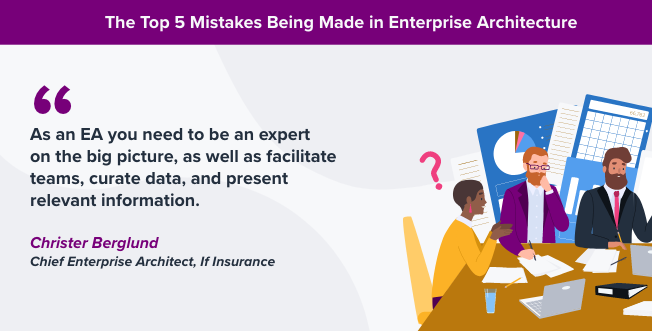
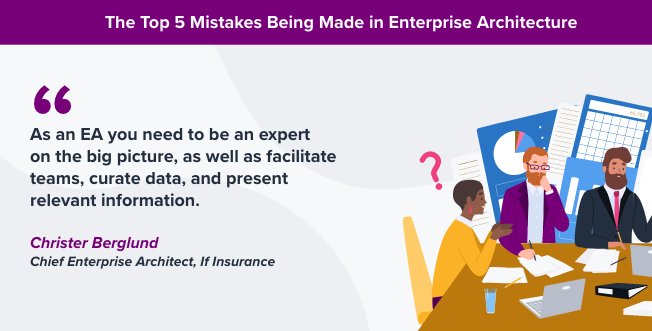
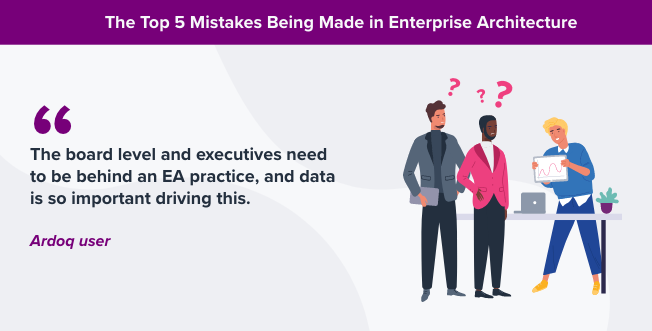
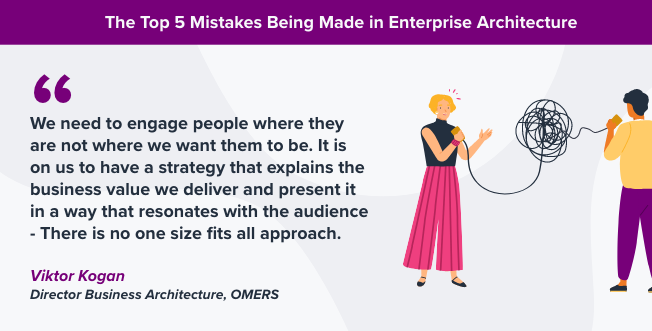
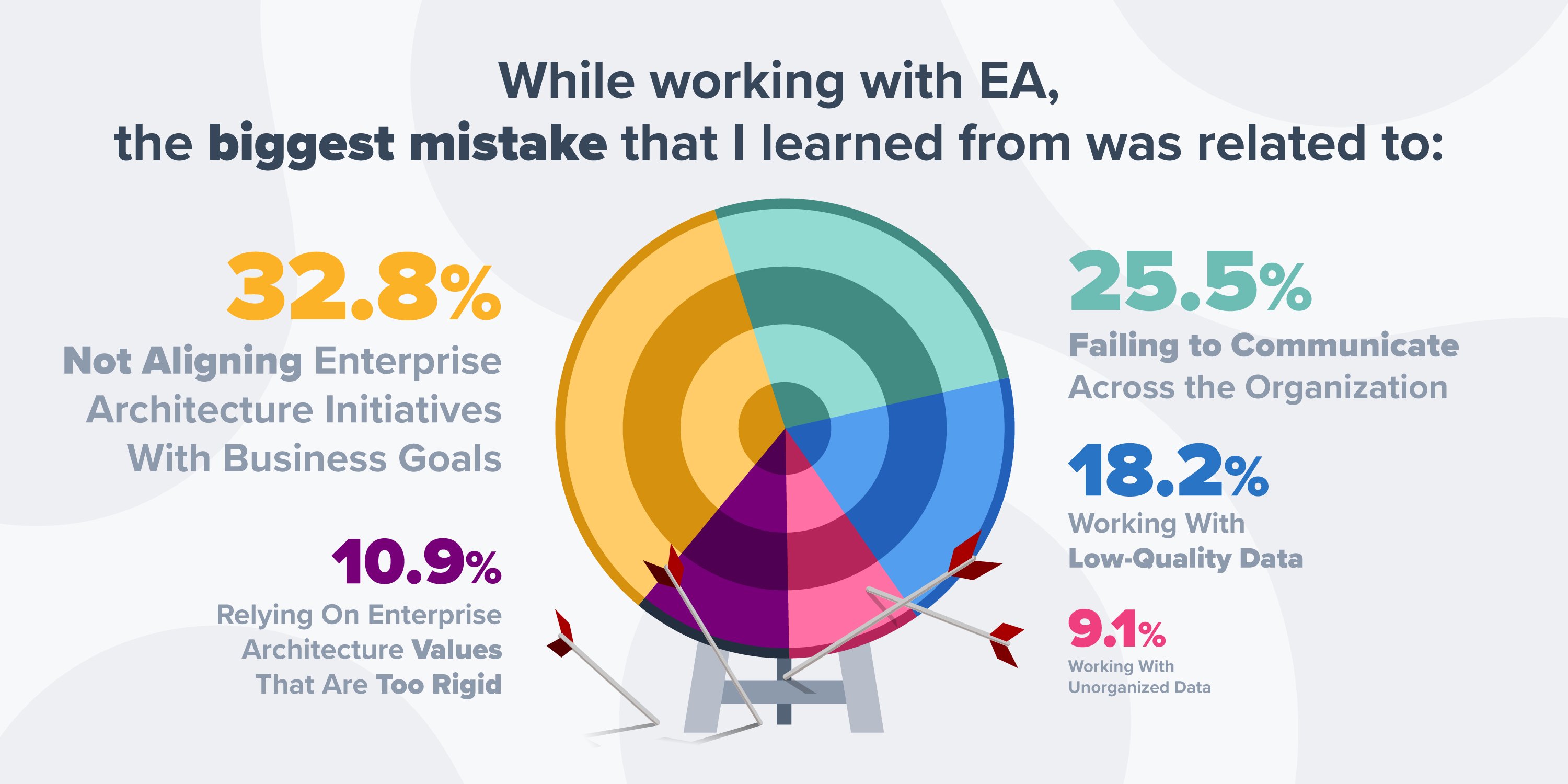
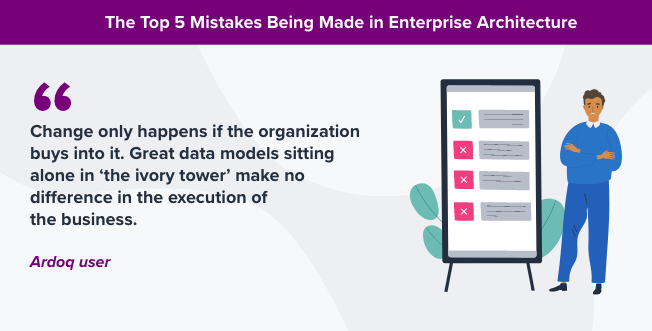
/Logos/Ardoq/RGB_Ardoq_Logo_Stacked_White_Monochrome%201.png?width=80&height=77&name=RGB_Ardoq_Logo_Stacked_White_Monochrome%201.png)

